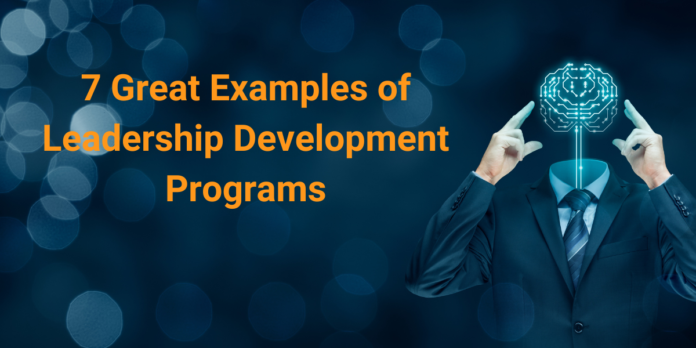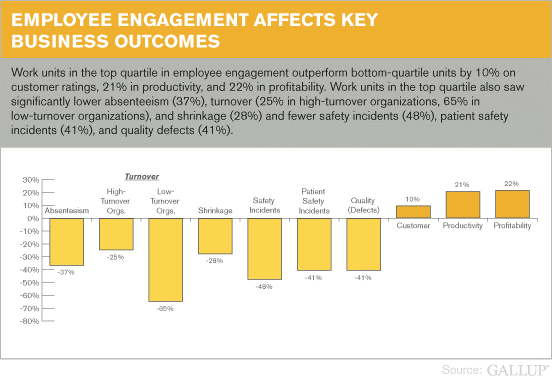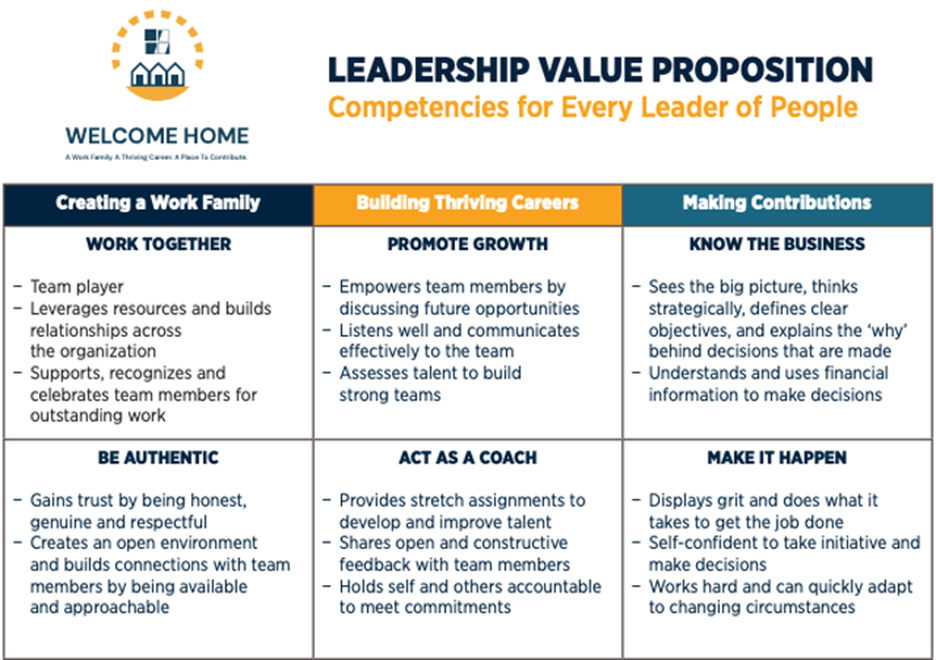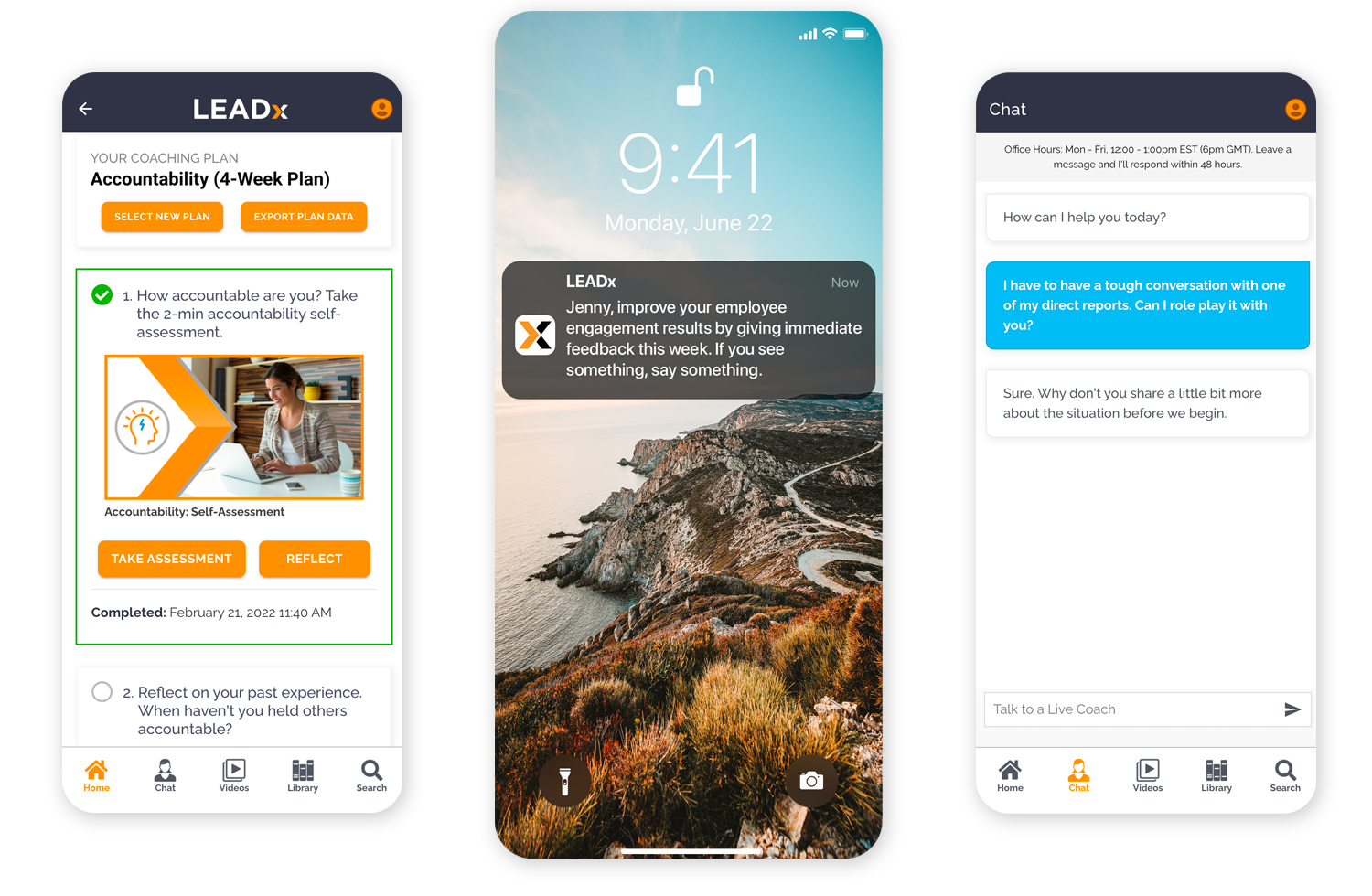
7 Great Examples of Leadership Development Programs
A strong leadership development program is the lever for engagement and culture.
In his book, When They Win, You Win, author Russ Laraway does a brilliant job of drawing out the connection between not only leadership development and engagement but also engagement and bottom-line business results.
Laraway breaks it down as follows:
Managers account for 70% of engagement. And, engagement is directly tied to results. For example, companies scoring in the top 25% of engagement saw 95% better earnings per share. Research also shows that companies scoring in the top 25% of employee engagement are 17% more productive and 21% more profitable.
 The big idea? Develop good leaders to develop a thriving business.
The big idea? Develop good leaders to develop a thriving business.
So what exactly does a GOOD leadership development program look like? Of course, there’s no one answer. Different programs succeed in different organizations for different reasons.
That’s why instead of prescribing a “how-to” guide for developing a leadership program, this article takes a more exploratory approach. Based on our dozens of interviews with leadership development pros, we share seven high-value examples of leadership development programs from seven different organizations.
Of course, these examples don’t capture every aspect of each leadership development program (each would need its own book). Instead, the examples hone in on a unique aspect of each program that you can think about, compare to your own program, repurpose, or even borrow. The choice is yours!
7 Examples of Leadership Development Programs
If a certain program or idea catches your eye as you read through these examples, just follow the link at the bottom of that section to read the full interview.
Example #1: Competency-Based Leadership Dev at Associa
It can be tempting to train interesting topics, but interest alone doesn't equal impact. To ensure they maximized the value of their frontline leadership program, Associa built their program directly around their competencies. Each of six weekly sessions covers a specific competency, why it's important, how it impacts the business, and key behaviors to uphold it. On top of that, they built their own simple self-assessment based on each behavior. Before and after the program, leaders take the self-assessment to evaluate their behavior on each of the competencies.
Read the full interview with Associa here.

Example #2: A Top to Bottom Cascade of Learn-Teach at Intuit
Research shows that “manager support” is one of the greatest barriers leaders feel toward investing time and energy into learning and development. What better way to prove the value of training and show manager support than to have your manager go through training before you and then literally co-teach the material to you later on…
Intuit did exactly that. They rolled out their leadership development program by centering it around one book— their Leadership Playbook. The rollout was led by their CEO and C-suite who brought it to life with stories and examples. Then, they focused on training VPs in a cohort-based experience—five to seven VPs went through three, two-hour Zoom sessions over two months. The program was co-facilitated by their leadership development team and their C-suite.
VPs spent the last session working on their “teachable point of view.” They wrote out observations and experiences that they could then teach to their directors. After the directors went through the program, they taught what they learned down to their managers. This cascade of leadership development sets the tone, models behavior, and helps grow knowledge through teaching.
Read the full interview with Intuit here.
Example #3: Nudges and Micro-Learning at LA Public Library
Application is everything when it comes to learning. Research shows that participants in day-long programs retain only 15% of knowledge or less. And, that doesn’t even get into whether or not they apply what they learned. On the opposite end of the spectrum, research shows that learning that focuses on application is actually retained better than learning that focuses on learning.
All this to say, LA Public Library is a prime example of application in learning. Instead of sending a handful of people to a single conference or off-site leadership training, LA Public Library implemented a much more accessible, organization-wide program. They offered micro-learning to 120 managers and executives. Each week, leaders received 15 to 30 minutes of actionable micro-learning. To motivate learners and hone in on application, they did four key things:
- Made it accessible. The microlearning arrived by email, and it only took one click to access and 15-30 minutes to complete.
- Made it obvious. Nudges reminded leaders of weekly micro-learnings and even delivered the micro-learnings directly to their inboxes.
- Made it interesting. Leaders could choose what they wanted to learn, and the micro-learnings would adjust to fit their choices.
- Made it satisfying. By emphasizing application, employees were able to apply micro-learnings on the job and see the value in real time.
Read the full interview with LA Public Library here.
Example #4: Pulse-Driven Leadership Dev at UiPath
The push toward measurement is growing stronger and stronger. And that makes sense; measurement matters more than ever before. But, this push can lead some people to set up unnecessarily complex systems of measurement. At worst, leadership development pros may feel so overwhelmed by measurement that they do nothing or stick to “butts in seats” and cheesy “smile sheets.”
UiPath is one of the simplest, most elegant examples of how measurement can be used to evaluate and improve your leadership development. Simply put, they use an annual engagement survey to determine areas of need. Then, as they roll out training, they use a kind of constant system of pulses to check if behavioral change is actually happening. For example, after a session for managers on “having meaningful conversations with their employees,” a pulse would be sent out to direct reports of managers asking, “Have you had a good conversation with your manager in the last month.” The responses help UiPath to not only get a sense of whether or not their training is working, but also to get a sense of specific people, departments, or teams that might need further training.
Read the full interview with UiPath here.
Example #5: Peer Learning Networks at Catholic Health
One of the best ways to create a high-performing learning system is to create one that’s self-organizing. Peer learning networks activate learning by creating a common space to share and learn from one another. In peer learning networks, employees can interact, ask questions, and share stories and examples related to the training they just went through. Long-term, these threads become a record of insights for new employees, employees who are going through the same training, and for the learning and development department to draw from.
Catholic Health is activating a system just like that across their hospitals in Long Island, New York. Their CLO, Tom Bidga-Peyton described it as follows:
“Someone will bring an actual problem they’re currently facing to the table as a case study. The facilitator will help frame their problem to a cohort of 8-10 people, then employees will go around the table (or online forum) sharing their perspectives. Ideally, the person who brought a problem in listens to their colleagues. By the end, they will think about and see their problem differently. They will take away a new angle, an interesting idea, or a question to work from. Everyone participating will start to realize how the problems they’re facing are similar. So whether the learning was about decision-making, problem-solving, or collaboration, people begin to see how the formal learnings can be applied on the job.”
Read the full interview with Catholic Health here.
Example #6: Mentorships at Republic First Bank
Research shows that leadership mentoring can be one of the most effective ways to learn, grow, and engage leaders. Among the most valued leadership development offerings at Republic Bank is the Red Key Development Program. The Red Key is a 12-18 month program where leaders are paired with a mentor. Their mentor is a senior bank leader who helps give them exposure to other areas of the bank. Mentors even take leaders through back-office meet-and-greets to introduce them to senior leaders and departmental peers who they're going to work with. This helps leaders to not only learn about Republic First Bank’s overarching message of culture, people engagement, and expectations but also to see it in action.
Read the full interview with Republic First Bank here.
Example #7: Four Audiences, Four Distinct Programs, And One Common Thread at Deltek
All of Deltek’s leadership development programs share one common goal: To empower employees to solve real-world business challenges. That said, their programs are carefully tailored to each level of leader. Here’s the breakdown:
LEAD (Leadership Exploration and Discovery) — a foundational program for all employees, typically delivered during onboarding. Developed entirely in-house and online, this program focuses on Deltek’s values and how to apply those values on the job.
LEAD 2 — delivered twice a year to small cohorts, this program supports “team leads” and leverages roleplay scenarios. They also train leaders in how to develop team productivity through project management and coaching.
LAMP (Leadership Accelerator Management Program) — a six-month program required of all new managers and focused on recruitment practices, performance management, and leading and building teams. The set-up is self-directed learning with debrief sessions where managers can share and learn from one another.
LEAP (Leadership Engagement with Awesome People) — targeted at director-level leaders, participants must be nominated and accepted into this four-month-long program. Deltek’s CEO and executive team lead activities on a variety of topics: strategic thinking, fostering vision, innovation, employee engagement, influence and persuasion, managing conflict, collaboration, and relationship building. At the end, directors put together and present a capstone project to senior leaders.
Read the full interview with Deltek here.
Whatever Path You Choose, Make Learning Stick!
Whatever program you end up building, and whichever of these examples of leadership development programs you pull from, one thing remains true across all programs. The most successful programs turn learning into behaviors. That’s why at LEADx we use the 3-to-1 model: For every one formal learning, participants engage in three on-the-job application exercises.
Additional Reading:
45 Great Names for Leadership Development Programs
Additional Interviews with Leadership Development Pros:






